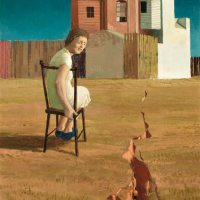33. JEFFREY SMART

Painted in 1959, The Earthquake represents an important transitional phase for Jeffrey Smart. Author Barry Pearce cited this period between 1955 and 1961 as the moment when Smart began to refine himself as the painter now widely recognised.1 Four solo exhibitions at Macquarie Galleries during these years saw growing commercial success, with reviewers coming to terms with his, consistent style of surrealism, or rather, heightened realism.2
This era comes after he spent time travelling through Europe and the United States absorbing the masterpieces that Paris, London, and New York could offer that 1950s Adelaide could not. Indeed, reviews of his 1959 exhibition, which included The Earthquake, compared his works to American painters Andrew Wyeth (1917-2009) and Edward Hopper (1882-1967), and Belgian painter Paul Delvaux (1897-1994).3
Smarts paintings of this period stand apart from the two main streams of modern art that were dominating Melbourne and Sydney. His semi-surrealist pictures had nothing in common with the abstract approach that characterised the Sydney art scene, nor with the reactionary fierce figurative paintings of the Melbourne school. Instead, he created something unique by combining his favoured devices of architecture to create geometrically sound compositions and narrative elements to create ambiguity. As art critic John McDonald put it, Despite the exacting manner in which he constructs a composition, Smarts best paintings are as ambiguous as dreams. They are infinitely suggestive, but confirm nothing.4
That is certainly apparent in The Earthquake, where the dramatic fissure in the foreground brings both a sense of surrealism and sparks an unsolvable narrative. Additionally, it acts as a compositional device to give scale and draw the viewer into the scene, as it weaves menacingly towards the building in the background. Surrealist painter, James Gleeson (1915-2008), made specific comment on this piece when reviewing the 1959 exhibition, saying that:
We are precipitated into a world where commonplace things are fraught with a disturbing significance. Certain phrases of Surrealism are echoed in the dreamlike quality of these paintings. The most potent of these fantasies is called The Earthquake.5
Smarts earlier works of the 1940s were almost entirely devoid of human figures, with the present work marking a turning point towards the distinctive singular characters, such as the bald suited man or the woman with the umbrella, that we have come to expect. The womans expression in The Earthquake is unusually emotive for Smart, perhaps unsurprising given her present situation. However, this is not the first time we see this seated figure positioned outward but turning to face the viewer, with her right arm hooked over the back of the seat Smart also adopts this pose for the figure in Bus Stop 1955, painted 4 years earlier. Smart was wary of the inclusion of figures, wanting to use them for scale and intrigue, but not wanting them to distract from the overall composition. He said, You have to be very careful because as soon as you put a figure in a painting the viewers eye goes straight to it, like a magnet. So I try not to make them too interesting; they are never beautiful or sexy.6
The success of the recent Jeffrey Smart major survey exhibition at the National Gallery of Australia demonstrates the enduring appreciation for Smarts oeuvre. With a career spanning seven decades, Smart was a unique voice in Australian art and this impact is still felt today.
FOOTNOTES
1. Pearce, B., Jeffrey Smart, The Beagle Press, Sydney, 2005, p.118
2. Quartermaine, P., Jeffrey Smart, Gryphon Books, Melbourne, 1983, p.125
3. Ibid.
4. McDonald, J., Introductory Essay, Jeffrey Smart: Recent Paintings, Philip Bacon Galleries, Brisbane, 2001, p.5
5. Gleeson, J., Strange Design in Art, The Sun, 16 September 1959
6. Jeffrey Smart, quoted in Capon, E., Jeffrey Smart Retrospective, Art Gallery of New South Wales, Sydney, 1999, p.92
Asta Cameron